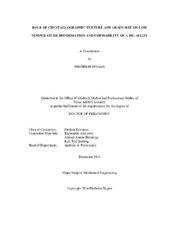| dc.description.abstract | Interest in Mg alloys has significantly increased in recent years for weight-critical applications. However, Mg alloys show low strength and poor low temperature formability, due to the limited available slip systems and the strong final texture in wrought products. This limits extensive usage of Mg as a structural material. Mg alloys have a hexagonal close-packed crystal structure that shows lower symmetry compared to its cubic counterparts, which causes activities of various Burgers vectors and slip planes under different stress fields. In this study, it was shown that detailed knowledge of multiple deformation mechanisms can be utilized to engineer the microstructure and flow anisotropy of magnesium alloys, subjected to severe plastic deformation, for ultrahigh strength, ductility, and formability.
Using a microstructure based visco-plastic self-consistent crystal plasticity model with detailed electron backscatter diffraction analyses and transmission electron microscopy, new equal channel angular processing (ECAP) methodologies were developed in order to achieve the desired microstructure and grain refinement to a few hundred nanometers. Both experimental and simulation results clearly indicated that the formation of compression/double twins causes deformation localization, followed by dynamic recrystallization within the twins. This non-uniform DRX causes local softening and macro shear banding, and eventual failure. However, it was shown that with proper modification of the texture and grain size, the shear localization and macro shear bands can be suppressed by limiting the twinning activity and, instead, promoting non-basal slip activities at low temperatures (<200°C). These studies led to the ultrahigh strength levels in the Mg-3Al-1Zn (AZ31) alloy.
To date, ECAP of Mg alloys is limited to bar/billet form, and a scale-up of the ECAP technology was not utilized for Mg plate and sheet processing. This work is one of the initial studies where commercially available wrought AZ31 plates are processed via the equal channel angular plate extrusion (ECAPE) tool in order to refine grains and weaken the strong wrought texture. The ECAPE tool provided scaled-up samples for further tests, such as stretch formability, a capability which was not possible with bar samples. It has been shown that ECAPE processing tremendously increased the room temperature stretch formability of AZ31 alloy sheets. | en |


